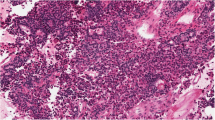Abstract
The fourth edition of the World Health Organization classification of endocrine tumors has been recently published. There are two critical changes to the classification for pituitary adenomas in this edition. One is that the term “atypical adenoma,” which was characterized based on highly proliferative properties to predict adenomas that carry a poor prognosis, was completely eliminated due to the lack of definitive evidence. The other change is the introduction of more precise cell lineage-based classification of pituitary adenoma that is defined based on lineage-specific transcription factors and hormones produced. Accordingly, null cell adenomas have been re-defined as those that show completely negative immunostaining either for hormones or for adenohypophyseal transcription factors. In this review, we summarized these changes in the WHO classification and discussed topics that are relevant to the diagnosis of actual cases: immunohistochemical study for pituitary endocrine tumors, predictive markers for malignant potential, the relationship between somatotroph adenomas and somatostatin analogs, and characteristics of plurihormonal adenomas.


Similar content being viewed by others
References
Osamura RY, Lopes MBS, Grossman A, Kontogeorgos G, Trouillas J (2017) Introduction. In: Lloyd RV, Osamura RY, Klöppel G, Rosai J (eds) World health organization classification of tumours of endocrine organs, 4th edn. IARC, Lyon, p 13
Osamura RY, Lopes MBS, Grossman A, Matsuno A, Korbonits M, Trouillas J, Kovacs K (2017) Pituitary adenoma. In: Lloyd RV, Osamura RY, Klöppel G, Rosai J (eds) World health organization classification of tumours of endocrine organs, 4th edn. IARC, Lyon, pp 14–18
Lopes MBS (2017) The 2017 World Health Organization classification of tumors of the pituitary gland: a summary. Acta Neuropathol 134:521–535
Mete O, Lopes MBS (2017) Overview of the 2017 WHO classification of pituitary tumors. Endocr Pathol 28:228–243
DeLellis RA, Lloyd RV, Heitz PU, Eng C (eds) (2004) Pituitary tumours: introduction. In: World health organization classification of tumours of endocrine organs, 3rd edn. IARC, Lyons, pp 10–13
Asa SL, Ezzat S (1999) Molecular determinants of pituitary cytodifferentiation. Pituitary 1:159–168
Al-Shraim M, Asa SL (2006) The 2004 World Health Organization classification of pituitary tumors: what is new? Acta Neuropathol 111:1–7
Kontogeorgos G (2005) Classification and pathology of pituitary tumors. Endocrine 28(1):27–35
Laws ER Jr, Lopes MBS (2006) The new WHO classification of pituitary tumors: highlights and areas of controversy. Acta Neuropathol 111:80–81
Trouillas J, Roy P, Sturm N et al (2013) A new prognostic clinicopathological classification of pituitary adenomas: a multicentric case–control study of 410 patients with 8 years post-operative follow-up. Acta Neuropathol 126:123–135
Nishioka H, Kontogeorgos G, Lloyd RV, Lopes BS, Mete O, Nose V (2017) Pituitary gland: null cell adenoma. In: Lloyd RV, Osamura RY, Klöppel G, Rosai J (eds) WHO classification of tumours of endocrine organs, 4th edn. IARC, Lyon, pp 37–38
Nishioka H, Inoshita N, Mete O, Asa SL, Hayashi K, Takeshita A, Fukuhara N, Yamaguchi-Okada M, Takeuchi Y, Yamada S (2015) The complementary role of transcription factors in the accurate diagnosis of clinically nonfunctioning pituitary adenomas. Endocr Pathol 26:349–355
Sjöstedt E, Bollerslev J, Mulder J, Lindskog C, Pontén F, Casar-Borota O (2017) A specific antibody to detect transcription factor T‑Pit: a reliable marker of corticotroph cell differentiation and a tool to improve the classification of pituitary neuroendocrine tumours. Acta Neuropathol 134:675–677
Kaltsas GA, Nomikos P, Kontogeorgos G, Buchfelder M, Grossman AB (2005) Clinical review: diagnosis and management of pituitary carcinomas. J Clin Endocrinol Metab 90(5):3089–3099
Asa SL, Casar-Borota O, Chanson P, Delgrange E, Earls P, Ezzat S, Grossman A, Ikeda H, Inoshita N, Karavitaki N, Korbonits M, Laws ER Jr, Lopes MB, Maartens N, McCutcheon IE, Mete O, Nishioka H, Raverot G, Roncaroli F, Saeger W, Syro LV, Vasiljevic A, Villa C, Wierinckx A, Trouillas J; and the attendees of 14th Meeting of the International Pituitary Pathology Club, Annecy, France, November 2016 (2017) Pituitary adenoma to pituitary neuroendocrine tumor (PitNET): an international pituitary pathology club proposal. Endocr Relat Cancer 24:C5–C8
Mete O, Korbonits M, Osamura RY, Trouillas J, Yamada S (2017) Somatotroph adenoma. In: Lloyd RV, Osamura RY, Klöppel G, Rosai J (eds) WHO classification of tumours of endocrine organs, 4th edn. IARC, Lyon, pp 19–23
Kontogeorgos G, Kovacs K, Lloyd RV, Righi A (2017) Plurihormonal and double adenoma. In: Lloyd RV, Osamura RY, Klöppel G, Rosai J (eds) WHO classification of tumours of endocrine organs, 4th edn. IARC, Lyon, pp 39–40
Mete O, Gomez-Hernandez K, Kucharczyk W, Ridout R, Zadeh G, Gentili F, Ezzat S, Asa SL (2016) Silent subtype 3 pituitary adenomas are not always silent and represent poorly differentiated monomorphous plurihormonal Pit-1 lineage adenomas. Mod Pathol 29(2):131–142
Mori R, Inoshita N, Takahashi-Fujigasaki J, Joki T, Nishioka H, Abe T, Fujii T, Yamada S (2013) Clinicopathological features of growth hormone-producing pituitary adenomas in 242 acromegaly patients: classification according to hormone production and cytokeratin distribution. ISRN Endocrinol 2013:723432
Acknowledgements
The authors are grateful to Dr. Shozo Yamada, our chief surgeon, for various clinical data and to Dr. Yoshitaka Hippo, for helpful discussion and critical reading of the manuscript. This work was in part supported by JSPS KAKENHI Grant number JP25460468.
Author information
Authors and Affiliations
Corresponding author
Rights and permissions
About this article
Cite this article
Inoshita, N., Nishioka, H. The 2017 WHO classification of pituitary adenoma: overview and comments. Brain Tumor Pathol 35, 51–56 (2018). https://doi.org/10.1007/s10014-018-0314-3
Received:
Accepted:
Published:
Issue Date:
DOI: https://doi.org/10.1007/s10014-018-0314-3




